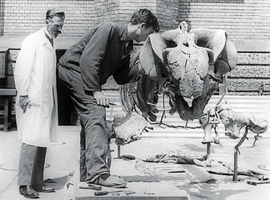Friedrich von Huene
| Friedrich Richard von Hoinigen | |
|---|---|
| Born |
March 22, 1875 Tübingen |
| Died |
4 April 1969 (aged 94) Tübingen |
| Residence | Tübingen |
| Nationality | German |
| Fields | paleontologist |
| Known for | Friedrich von Huene |
Friedrich von Huene, full name Friedrich Richard von Hoinigen (March 22, 1875 – April 4, 1969) was a German paleontologist who renamed more dinosaurs in the early 20th century than anyone else in Europe. He also made key contributions about various Permo-Carboniferous limbed vertebrates.
Biography

Huene was born in Tübingen, Kingdom of Württemberg. His discoveries include the skeletons of more than 35 individuals of Plateosaurus in the famous Trossingen quarry, the early proto-dinosaur Saltopus in 1910, Proceratosaurus in 1926, the giant Antarctosaurus in 1929, and numerous other dinosaurs and fossilized animals like pterosaurs. He also was the first to naming several higher taxa, including Prosauropoda and Sauropodomorpha.
He visited the Geopark of Paleorrota in 1928, and there collected the Prestosuchus chiniquensis in 1938.
He also studied several Permo-Carboniferous and Triassic limbed vertebrates, including members of several large clades, such as Temnospondyli,[1] Synapsida,[2][3][4] and Sauropsida.[5][6] In his work on mesosaurs,[6] Huene indicated that a lower temporal fenestra was present (as in synapsids), an interpretation later rejected by many subsequent workers,[7][8] but more recently upheld.[9]
A new species of basal sauropodomorph, Lufengosaurus huenei, was named after von Huene in 1941. Liassaurus huenei, an early carnivorous theropod, was named for him in 1995, though this name is invalid.
References
- ↑ Huene, Friedrich von (1910). "Neubeschreibung des permischen Stegocephalen Dasyceps bucklandi (Lloyd) aus Kenilworth". Geologische und Paleontologische Abhandlungen. 8: 325–338.
- ↑ Huene, Friedrich von (1905). "Pelycosaurier im deutschen Muschelkalk". Neues Jahrbuch für Mineralogie, Geologie und Paläontologie. 20: 321–353.
- ↑ Huene, Friedrich von (1908). "Neue und verkannte Pelycosaurier-Reste aus Europa". Centralblatt für Mineralogie, Geologie und Paläontologie. 14: 431–434.
- ↑ Huene, Friedrich von (1925). "Ein neuer Pelycosaurier aus der unteren Permformation Sachsens". Geologische und Paleontologische Abhandlungen. 18 (Neu Folge 14): 215–264.
- ↑ Huene, Friedrich von (1912). "Die Cotylosaurier der Trias". Palaeontographica. Abteilung A. Palaeozoologie-Stratigraphie. 59: 69–102.
- 1 2 Huene, Friedrich von (1940). "Osteologie und systematische Stellung von Mesosaurus". Palaeontographica. Abteilung A. Palaeozoologie-Stratigraphie. 92: 45–58.
- ↑ Modesto, S.P. (1999). "Observations of the structure of the Early Permian reptile Stereosternum tumidum Cope". Palaeontologia Africana. 35: 7–19.
- ↑ Rossmann, T.; Maisch, M. W. (1999). "Das Mesosaurier-Material in der Bayerischen Staatssammlung für Paläontologie und Historische Geologie: Übersicht und neue Erkenntnisse". Mitteilungen der Bayerischen Staatssammlung Für Plaäontologie und historische Geologie. 39: 69–83.
- ↑ Piñeiro, G.; Ferigolo, J.; Ramos, A.; Laurin, M. (2012). "Cranial morphology of the Early Permian mesosaurid Mesosaurus tenuidens and the evolution of the lower temporal fenestration reassessed". Comptes Rendus Palevol. 11 (5): 379–391. doi:10.1016/j.crpv.2012.02.001.
- Westphal, Frank (1972) "Huene, Friedrich von" In Neue Deutsche Biographie (volume 9 Heß–Hüttig), Duncker & Humblot, Berlin, pages 740–741
- Isaia, Antônio. Os Fascinantes Caminhos da Paleontologia (Dazzling Paleonotogical Paths) (in Portuguese). Porto Alegre, Brazil: Grafica Editora Pallotti. length: 60 pages; Guide to the fossil finds in Rio Grande do Sul, and especially in the Santa Maria area.
- Beltrão, Romeu (1979). Cronologia Histórica de Santa Maria e do extinto município de São Martinho: 1787-1930 (in Portuguese) (second ed.). Grafica Editora Pallotti. OCLC 10022858. length: 582 pages